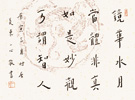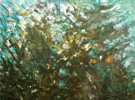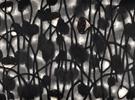
展览时间:2010-09-04 ~ 2010-10-31
展览地点:麦勒画廊
参展艺术家:单凡
开幕时间:2010-09-04 16:00~19:00
展览介绍:
历经三十年,艺术家单凡(1959年生于杭州)的生活一直围绕着竹画展开。他在中国上大学时全面掌握了传统中国水墨画技法;上世纪八十年代,他移居汉堡,研究西方抽象艺术的经历使得他对自身文化传统的视角有所改变。竹画从本源上说就有趋于抽象的特点,这一特点被单凡加以反思利用,并通过各种形式,如宣纸水墨画、架上油画、为古代名家的画作填色以及行为艺术等表现出来。单凡把线变成了面,把瞬间延展为持久,“不可逆性”的概念变为了实在的物理经验。展览故乡——瞬时之作与缓慢之作以回顾的方式再现了单凡创作的发展过程,同时也呈现了单凡着手进行的持续性项目的一个阶段。
在汉堡的最初几年,单凡仍继续用传统水墨技法进行创作。单凡的《緩慢之作》,用浓厚的黑色在宣纸上画竹茎和青草,作品似乎笼罩在一层看不见的“色雾”中。与前辈古代大师相比,单凡另辟新路,走入全新的领域,其独特性跃然纸上。放大的竹茎取代了茎叶相间的浓密,成为了单凡画作的主题。画的中央是留白。通过描画折断的竹茎,单凡进一步从传统形式中解放出来。竹茎折向不同的方向,凸显出某种疼痛感。单凡说:“把竹子折断并不是什么攻击性的行为。我已经更为清楚地认识到,如果要保持传统的活力,就要在某种程度上‘折断’自己与传统的关系。”
直到今天,单凡一直在进行着他独特的“竹画重构”工作。同时,于2008年,他挑选出12幅竹画作品,用精细的笔触将之改造成为大型的油画作品。这些作品成为后来画作中那些展现如同在近镜头下观看细节的基础。他说:“我总是把一节一节的小竹段用相同大小的画面展现出来,让人从画面上看不出来画的是竹子。”在这种材料美学和生产美学的形式中,平面塑造以毫米为单位进行,毛笔笔法凝练和快速的特点被削弱。单凡使用的是勾圆的笔法,图像看起来似乎有种“吸力”。最终的结果是全黑或全白的(对于那些在白底上用白色勾画的作品而言)的平面,“瞬时之作”演变成为“缓慢之作”。
单凡在系列作品《填空》(2007年)中将他对中国传统水墨名作的思考用画笔诉诸纸上。他用了长达280小时的时间,将一幅临摹宋代画家文与可(文同)的竹画作品上的空白部分填满颜色。“这样一来,我们可以用肉眼看到‘虚’作为潜在的‘实’的特点,”单凡说道,“如同解构的过程,中国‘虚’的传统也在这种打破禁忌的过程中被消解掉了。这就是说,‘虚’也意谓着是一种‘缺失’。”画竹画的不再是为了在画的短暂过程中达致忘我之境,而是在静观冥想中反照自我。由此出发,单凡在作品《缓慢之作》(2009年)中用210小时完成了对清代思想家和书画家傅山的书法作品的续写。
行为作品《墨水人生漂不白》(2006年)有着影像一般的质感,最为全面地体现了单凡作品的表现力。作品实施过程中,黑墨泼满身穿白袍的单凡全身;泼墨之后再泼清水,把黑色淡化为明灰色。但无论泼多少水,黑色都不会被冲褪。作品题目的含义得到了实现:万事皆无逆转的可能,“前事”成为“后继”之师。
文:Ulrike Münter
翻译:苏伟
Shan Fan: HOMELAND Painting the Moment – Painting Slowness
For three decades, bamboo painting has been part of the everyday life of artist Shan Fan (b. 1959 in Hangzhou). He first became familiar with the techniques of traditional Chinese painting as a student in China, but when he moved to Hamburg, Germany, in the mid-1980s, his study of abstract western art altered the way he viewed his own traditions. Whether in ink on rice paper, in oil on canvas, in copying a traditional classic, or in the medium of performance, Shan Fan’s work reflects upon and transforms the medium of bamboo painting, which already has potentially abstract characteristics. For him, lines become planes, seconds become hours, entropy becomes a physical experience. His exhibition, HOMELAND Painting the Moment – Painting Slowness, traces this development, while at the same time marking a kind of phase in Shan Fan’s continuous work-in-progress project.
During his early years in Hamburg, Shan Fan continued to work with traditional ink painting techniques. Painting the Moment is represented by the stalks and grasses painted on rice paper in hues ranging from dense black to an almost transparent wisp of color. In comparison to the works of his classical role models, the viewer immediately notices that he is entering new compositional territory. Instead of bushy bamboo formations, Shan Fan’s paintings will simply depict a single stalk. The center itself, however, remains empty. The next step to emancipation is the broken bamboo stalk.Bending in various directions, the works, the images, seem to take on an almost painful dimension. “Breaking the bamboo,” says Shan Fan, “is not so much an act of aggression; rather, I’ve realized that I have to break with tradition to a certain degree, in order to be able to keep it alive.”
To this day, Shan Fan is persistently continuing his work on his Alphabet of Bamboo Painting. Parallel to this, he has been working since 2008 on transferring twelve selected bamboo paintings to large canvases, using oils and the finest brushes. Gradually, they are building the foundation for a series of pictures whose details make them seem almost like film close-ups. “Since I keep transferring increasingly smaller sections of a piece of bamboo onto the same size canvas, I eventually reach a point where it is no longer possible to recognize them as bamboo.” (Shan Fan) In accordance with the aesthetics of the artist’s material and production methods, he uses concentrated, rapid brush strokes, slowly panning the ink, as it were, across the surface, creating planes millimeter-by-millimeter. In deciding to use a circular brush movement, Shan Fan gives his images a vortex-like effect. The final result of this development is a black or—in the case of the white-on-white paintings—a white plane. Painting the Moment becomes Painting Slowness.
Shan Fan’s critical reflections upon Chinese classics are visually expressed in pictures such as Filling Emptiness (Leere Füllen). It took him 280 hours of meditative painting to fill in the empty spaces in a reproduction of a classic bamboo painting by Wen Yuke, an artist of the Song dynasty. “For one, this makes it possible to perceive a void as potentially full,” says Shan Fan, “for another, this violation of a taboo cancels out the Chinese tradition of emptiness, in a way that is similar to deconstruction. This means that a void is simultaneously labeled as “the lack of something.” From then on, the goal of bamboo painting is no longer to lose oneself in the brief moment of painting, but rather, to have a contemplative experience of the self. For this reason, Shan Fan extends the act of copying a piece of Chinese calligraphy, by the Qing dynasty painter Fu Shan, to a length of 210 hours, in his Kalligraphing Slowness (Kalligrafie der Langsamkeit) 2009. An overridingly important statement in Shan Fan’s oeuvre is his performance piece, Entropy (2006), which has been captured on film and in photographs. Black ink pours down over the white robe worn by the artist. Clear water follows, turning the black into a light gray. Yet no matter how much water is poured on, the traces of the black ink remain. The meaning of the title is visually represented: every occurrence is ultimately irreversible—everything affects the outcome of the future.
Ulrike Münter
Translation: Allison Plath-Moseley
- 2011-04-30 ~ 2011-05-30出窍记·缪晓春个展
- 2011-04-29 ~ 2011-05-20静中人Figures of Silence —Michel Madore
- 2011-04-30 ~ 2011-05-14黑白
- 2011-05-28 ~ 2011-07-28四重奏——孟昌明水墨荷花作品展
- 2011-05-28 ~ 2011-06-24“远与近”意大利当代著名艺术家作品展
- 2011-05-28 ~ 2011-07-02底下有石头:杨心广个展
- 2011-05-21 ~ 2011-06-20湖滨诗境──Celest生态摄影展(续展)
- 2011-05-21 ~ 2011-06-05缓行——十二位八零后艺术家
- 2011-04-28 ~ 2011-06-05观天悟道——张国龙艺术巡展
- 2011-05-28 ~ 2011-07-10诺特·维塔尔:激浸




